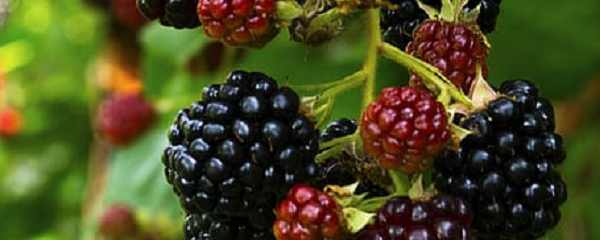

QUICK INFORMATION ABOUT BLACKBERRIES
PROPER NAME
Rubus Fruticosus
COMMON NAME
Blackberry
TYPE
Fruiting Perennial
HARDINESS ZONE
5 to 8 (Perennial)
GERMINATION
Canes/Bare Roots
MATURE SIZE
1-1.6m Tall / 1.6-2m Wide
SUN EXPOSURE
Full Sun
SOIL TYPE
Well-Drained, Rich & Loamy
SOIL PH
Acidic to Neutral (5.5 to 7.0)
BLACKBERRY
Nothing tastes better or is fresher than homegrown fruit, most people don’t have the space to have a full-grown fruit tree or melon vine at home, and situations like these are where berries find their place as a gateway fruit for home gardeners. There is nothing easier to grow in Canada as a Blackberry Bush, considering it’s a native North American fruiting shrub. You harvest Blackberries from mid-June through the end of August with very minimal maintenance to the bush. The only requirement for the shrub is a spot with full sun and high-quality soil.
Blackberries are typically sold as bare roots or in potted plants. The best time to plant a cane is in the early Spring, while the roots are still dormant. If you have the patience to wait for a seed to sprout, you can plant them in the ground in early Fall. Doing this will generally allow your bushes to start producing reasonable amounts of fruit in their second year of growth.
PLANTING TURNIPS
DEPTH
Cover Roots
PLANT/ROW SPACING
1.6m / 1.6m
GERMINATION
Canes/Bare Roots
DAYS TO MATURITY
Typically 2nd Year
PLANTING SEASON
Spring & Fall
Blackberries can tolerate almost any growing conditions, but a pampered plant will offer the best harvest through the season. Give your bush plenty of sunshine, lots of water and a rich, loamy, well-amended soil to grow in, and you won’t be disappointed. A bit of care and some extra nutrients through the growing season will give your plants the energy needed to produce large, juicy and delicious berries until the Fall.
Space your plants between 1.6 and 2 meters apart and 1.6 to 2.6 meters if you’re planting in rows. Always check your soil, and make the proper amendments before planting. Remember, your bushes require rich, well-drained, and loamy soil that is slightly acidic for best production. When planting canes, cover the roots by an inch or two. When transplanting a nursery pot, cover the soil with an extra inch.
It’s always a good idea to have support for your canes, whether it be a trellis or some other form of support.
PRUNING BLACKBERRIES
Blackberry roots are perennial, but the canes are biennial, meaning you must trim off the dead stalks after the 2nd year of production. We do this to make room for the new stalks, as the old ones will no longer produce.
When purchasing a shrub that hasn’t fruited from a Garden Center, you should trim the top after 1 meter of growth to stimulate new branch production, which allows for a greater fruit harvest. Once the cane has produced its fruit, the stalk should be trimmed back to the ground to allow for new growth.
Before any new growth has started in the Spring, you should trim back any winter kill and select the six best canes to grow in the coming season, culling the remainder.
CARING FOR BLACKBERRIES
LIGHT – Full sunlight is essential to the bush to allow maximum production. In warmer climates, a small amount of shade in the afternoon is tolerable.
SOIL – Be very selective when choosing a location for your bush, as they can live up to a decade with proper care. Plant in slightly acidic, rich and loamy soil, with good drainage, and avoid clay. Raised beds are ideal as they can help with drainage and prevent late frosts from damaging buds. Remove all weeds near your shrubs as the shallow roots are susceptible to competition for nutrients and water.
Always keep a good layer of mulch over the root zone of the bush, as it will feed the plants, keep the weeds down and conserve moisture.
WATER – A moderate amount of water is required each week, approximately 2.5cm each week, from rain or ground level watering. NEVER overwater as Blackberries don’t do well in wet soil.
TEMPERATURE/HUMIDITY – Blackberries require a period of cold dormancy to germinate. Due to their shallow root systems, they don’t do well below growing zone 5 due to temperatures routinely falling below zero degrees. Cold winter temperatures and wet soils in the Spring may lead to death for the bush. Hot and dry weather tends to stunt growth and produce seedy fruits.
FERTILIZER – Fertilize every Spring as your plants emerge from dormancy using a 10-10-10 formula. Fertilize once again in the Fall with manure and compost to improve the soil and suppress weeds.
VARIETIES OF BLACKBERRIES
ERECT THORNY BLACKBERRY
Erect Thorny Blackberries or “Shawnee” grow upright without support and have very sharp thorns that can tear clothing and flesh. This variety is somewhat cold resistant.
ERECT THORNLESS BLACKBERRY
Erect Thornless Blackberries or “Natchez” grow upright without support but doesn’t have any thorns. This variety can grow into a hedgerow if it spreads by suckers.
TRAILING THORNLESS BLACKBERRY
Trailing Thornless Blackberry has long sprawling canes that require support to hold them above the ground. “Chester” and “Triple Crown” tend to grow in clumps and can benefit from a trellis for support.
The “Prime-Ark Traveler” hybrid is known to produce fruit on both new and old canes through the season.
HARVESTING BLACKBERRIES
Due to the highly perishable nature of your fruit, you must follow its development carefully. Immature berries start green before turning red and into a deep glossy black when ripe. The berries will not continue to ripen after harvest, so be sure to pick a berry once it has turned completely black. Your berries will last up to 7 days in the refrigerator.
WINTERING BLACKBERRIES
When wintering your berry bushes, you need to keep them trimmed back and covered with a thick layer of mulch to protect them from the freezing temperatures.
PESTS & DISEASES AFFECTING BLACKBERRIES
Your bushes will be prone to Anthracnose, Stem Blight, and Crown Gall. Always be sure to purchase your disease-free plant stock from a reputable nursery, and plant your berries away from wild brambles, which may pass on the diseases.
Insect pests will include Stink Bugs and Raspberry Crown Borers. Keeping your plants vigorous and healthy will makes them less attractive to insects.
Brambles may also be affected by viral diseases from time to time. Raspberry Bushy Dwarf Virus and Blackberry Calico Virus will cause bright yellow splotches on the leaves. Affected plants need to be immediately removed and destroyed.
Education, Tutorials, Planning & More…
Click Here to Return to the Main Page


